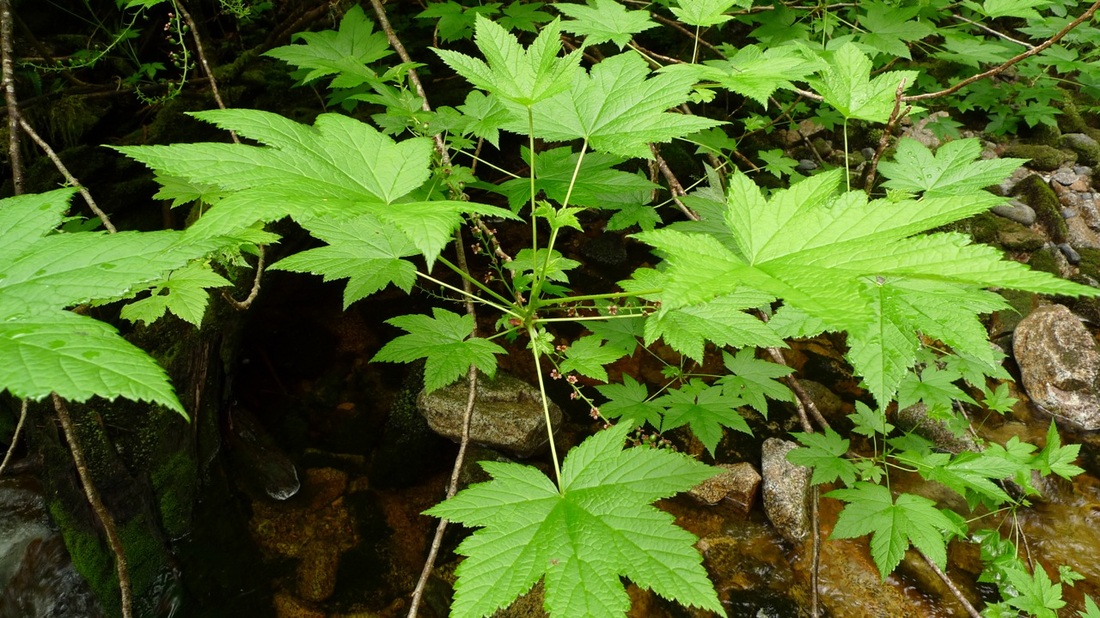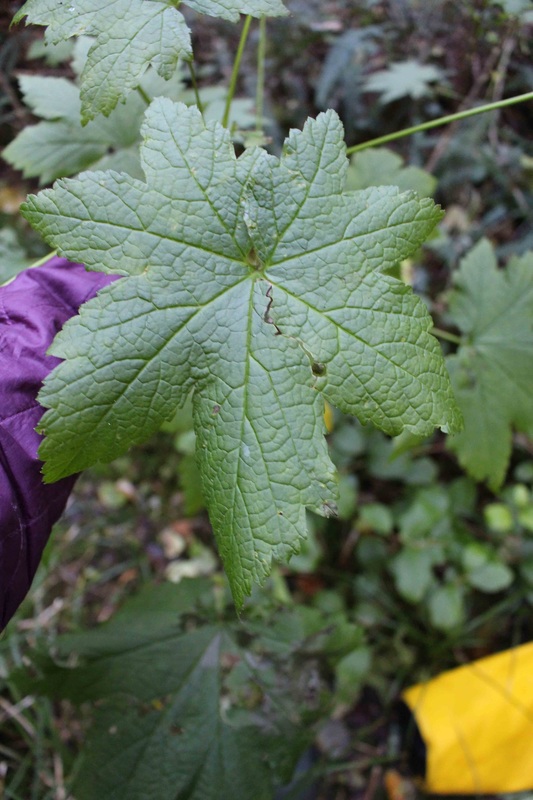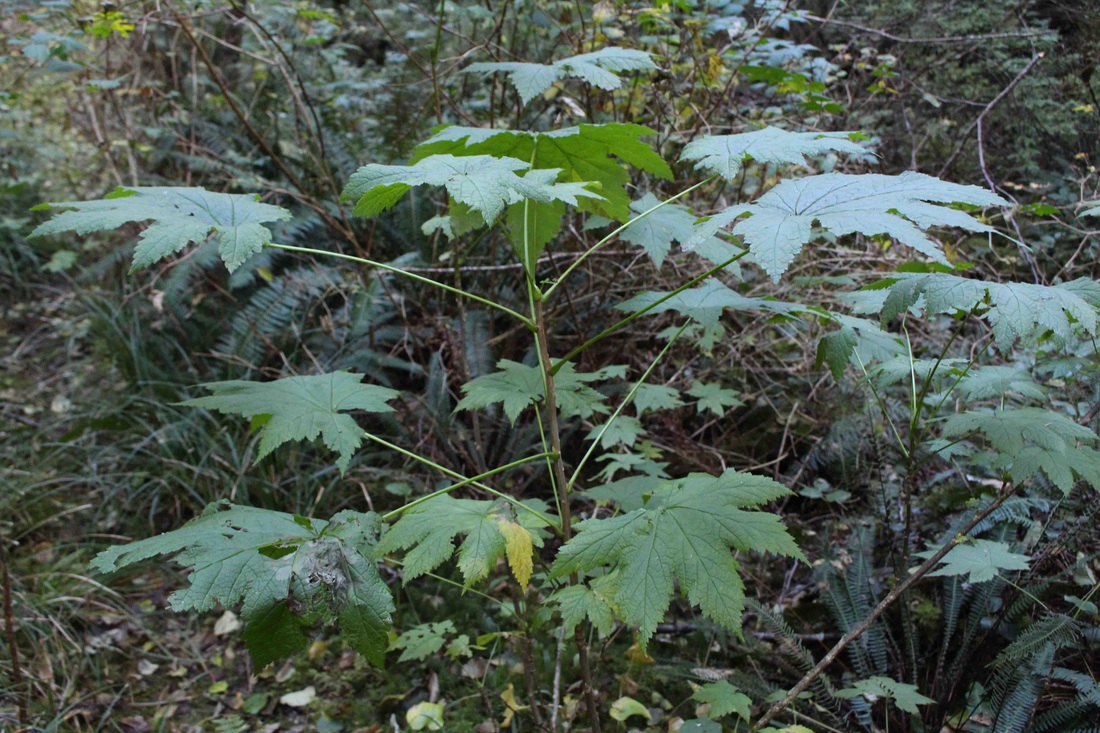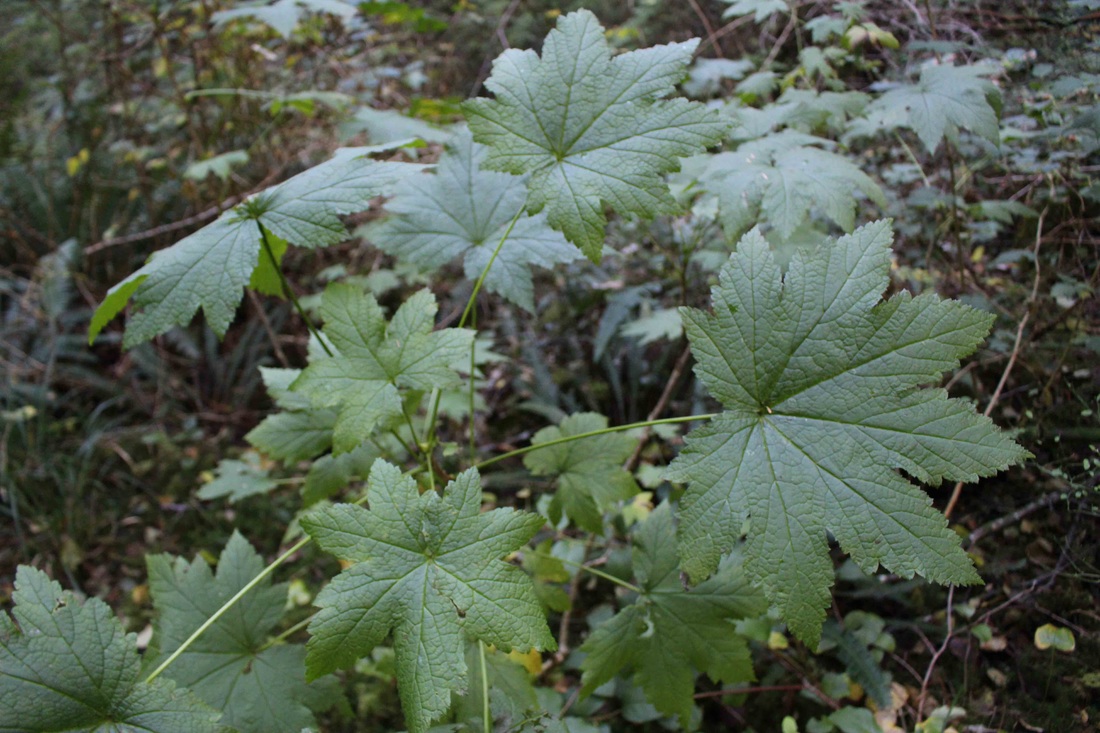Stink currant • Ribes bracteosum
Heiltsuk/Haíɫzaqv - p̓íp̓x̌sṃ • Nuxalk - q'is
Identification
Stink currant is an upright thorn-less shrub that grows to 3 m tall. It has a distinctive sweet-skunky smell, particularly when the leaves are crushed. Its leaves are large (5-20 cm wide) and somewhat maple-leaf-shaped with 5-7 lobes, and bear round yellow glands. Its white to greenish-white flowers form long clusters of 20-40 flowers. The fruits are bluish-black berries covered in a whitish bloom.
Habitat & Range
Stink currant grows in moist to wet locations, such as moist forests and thickets, streambanks, shorelines, floodplains, and avalanche tracks, from low to subalpine elevations. It is mostly found west of the Coast-Cascade Mountains, including Haida Gwaii and Vancouver Island, and ranges from southern Alaska to California.
Similar Species
The long flower and berry clusters are distinctive and help differentiate stink currant from similar Ribes species, as do its deeply lobed leaves. Its smell isn't necessarily the best ID characteristic, as the crushed leaves of all other Ribes species have strong smells as well.
Other plants with large maple leaf-like leaves include devil's club (Oplopanax horridus) and thimbleberry (Rubus parviflorus) Devil's club is armed with large spines and has small red (inedible) berries, while thimbleberry flowers and fruits are very obviously different from those of stink currant. Stink currant leaves are also more deeply lobed and with more sharply-pointed lobe tips.
Human Uses
Stink currant berries are edible, though their flavour can vary greatly. They are a traditional food source of many coastal First Nations. Harvest occurs in August and September.
iNaturalist
https://www.inaturalist.org/taxa/78852-Ribes-bracteosum
Stink currant is an upright thorn-less shrub that grows to 3 m tall. It has a distinctive sweet-skunky smell, particularly when the leaves are crushed. Its leaves are large (5-20 cm wide) and somewhat maple-leaf-shaped with 5-7 lobes, and bear round yellow glands. Its white to greenish-white flowers form long clusters of 20-40 flowers. The fruits are bluish-black berries covered in a whitish bloom.
Habitat & Range
Stink currant grows in moist to wet locations, such as moist forests and thickets, streambanks, shorelines, floodplains, and avalanche tracks, from low to subalpine elevations. It is mostly found west of the Coast-Cascade Mountains, including Haida Gwaii and Vancouver Island, and ranges from southern Alaska to California.
Similar Species
The long flower and berry clusters are distinctive and help differentiate stink currant from similar Ribes species, as do its deeply lobed leaves. Its smell isn't necessarily the best ID characteristic, as the crushed leaves of all other Ribes species have strong smells as well.
Other plants with large maple leaf-like leaves include devil's club (Oplopanax horridus) and thimbleberry (Rubus parviflorus) Devil's club is armed with large spines and has small red (inedible) berries, while thimbleberry flowers and fruits are very obviously different from those of stink currant. Stink currant leaves are also more deeply lobed and with more sharply-pointed lobe tips.
Human Uses
Stink currant berries are edible, though their flavour can vary greatly. They are a traditional food source of many coastal First Nations. Harvest occurs in August and September.
iNaturalist
https://www.inaturalist.org/taxa/78852-Ribes-bracteosum
References
Pojar, J. and MacKinnon, A. (1994). Plants of Coastal British Columbia, Revised. Vancouver, BC: Lone Pine Publishing. P. 86.
Ribes bracteosum Douglas ex Hook. In Klinkenberg, Brian. (Ed.). E-Flora BC: Electronic Atlas of the Plants of British Columbia. Lab for Advanced Spatial Analysis, Department of Geography, University of British Columbia, Vancouver. Accessed 15/07/2013.
Authors and editors of page
Kelly Fretwell and Brian Starzomski (2014).
Pojar, J. and MacKinnon, A. (1994). Plants of Coastal British Columbia, Revised. Vancouver, BC: Lone Pine Publishing. P. 86.
Ribes bracteosum Douglas ex Hook. In Klinkenberg, Brian. (Ed.). E-Flora BC: Electronic Atlas of the Plants of British Columbia. Lab for Advanced Spatial Analysis, Department of Geography, University of British Columbia, Vancouver. Accessed 15/07/2013.
Authors and editors of page
Kelly Fretwell and Brian Starzomski (2014).








